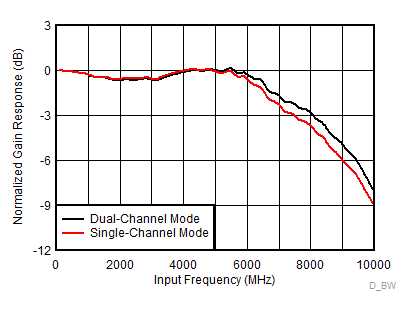ZHCSI83C may 2018 – may 2023 ADC12DL3200
PRODUCTION DATA
- 1
- 1特性
- 2应用
- 3说明
- 4Revision History
- 5Pin Configuration and Functions
-
6Specifications
- 6.1 Absolute Maximum Ratings
- 6.2 ESD Ratings
- 6.3 Recommended Operating Conditions
- 6.4 Thermal Information
- 6.5 Electrical Characteristics: DC Specifications
- 6.6 Electrical Characteristics: Power Consumption
- 6.7 Electrical Characteristics: AC Specifications (Dual-Channel Mode)
- 6.8 Electrical Characteristics: AC Specifications (Single-Channel Mode)
- 6.9 Timing Requirements
- 6.10 Switching Characteristics
- 6.11 Typical Characteristics
-
7Detailed Description
- 7.1 Overview
- 7.2 Functional Block Diagram
- 7.3
Feature Description
- 7.3.1 Analog Inputs
- 7.3.2 ADC Core
- 7.3.3 Timestamp
- 7.3.4 Clocking
- 7.3.5 LVDS Digital Interface
- 7.3.6 Alarm Monitoring
- 7.3.7 Temperature Monitoring Diode
- 7.3.8 Analog Reference Voltage
- 7.4
Device Functional Modes
- 7.4.1 Dual-Channel Mode (Non-DES Mode)
- 7.4.2 Internal Dither Modes
- 7.4.3 Single-Channel Mode (DES Mode)
- 7.4.4 LVDS Output Driver Modes
- 7.4.5 LVDS Output Modes
- 7.4.6 Power-Down Modes
- 7.4.7 Calibration Modes and Trimming
- 7.4.8 Offset Calibration
- 7.4.9 Trimming
- 7.5 Programming
- 7.6 Register Maps
- Application and Implementation
- 8Device and Documentation Support
- 9Mechanical, Packaging, and Orderable Information
封装选项
机械数据 (封装 | 引脚)
散热焊盘机械数据 (封装 | 引脚)
订购信息
3 说明
ADC12DL3200 是一款射频采样千兆采样模数转换器 (ADC),可对从直流到 10GHz 以上的输入频率进行直接采样。ADC12DL3200 在双通道模式下的最大采样速率为 3200MSPS,在单通道模式下的最大采样速率为 6400MSPS。该器件可通过编程方式针对通道数(双通道模式)和奈奎斯特带宽(单通道模式)进行权衡,方便用户开发灵活的硬件,从而满足高通道数或宽瞬时信号带宽应用的需求。它具有 8.0GHz 的全功率输入带宽 (-3dB) 和实用的频率范围,可对频率捷变系统的 L、S、C 和 X 频带进行直接射频采样。
ADC12DL3200 针对延迟敏感型应用采用低延迟的低电压差分信号 (LVDS) 接口,或在需要 LVDS 的简易性时使用该接口。该接口使用多达 48 个数据对、四个双倍数据速率 (DDR) 时钟和四个选通信号(安排在四条 12 位数据总线中)。该接口支持高达 1.6Gbps 的信号速率。选通信号可简化总线间和多个器件间的同步工作。选通信号是在内部产生的,并且 SYSREF 输入可在确定的时间将其复位。无噪声孔径延迟 (TAD) 调节和 SYSREF 窗口化等创新的同步特性进一步简化了多器件同步。
(1) 如需了解所有可用封装,请参阅数据表末尾的可订购产品附录。
(2) 封装尺寸(长 x 宽)为标称值,并包括引脚(如适用)。
 ADC12DL3200 频率响应
ADC12DL3200 频率响应